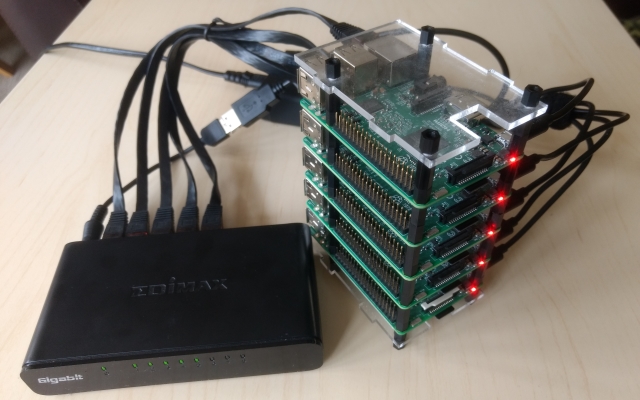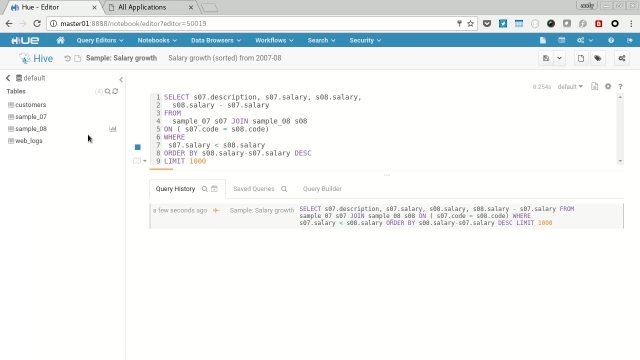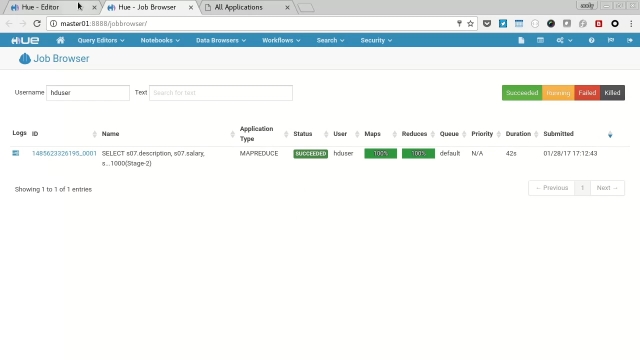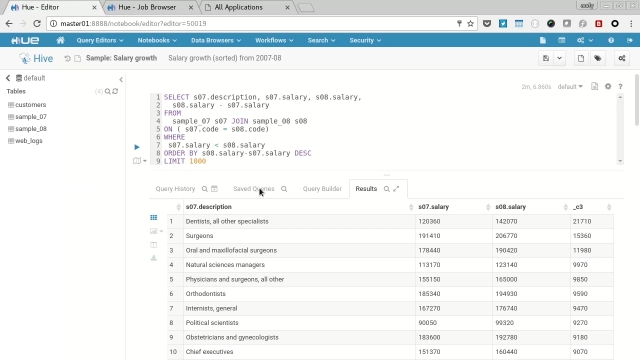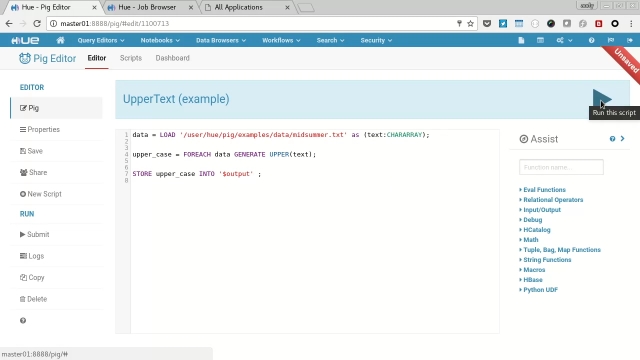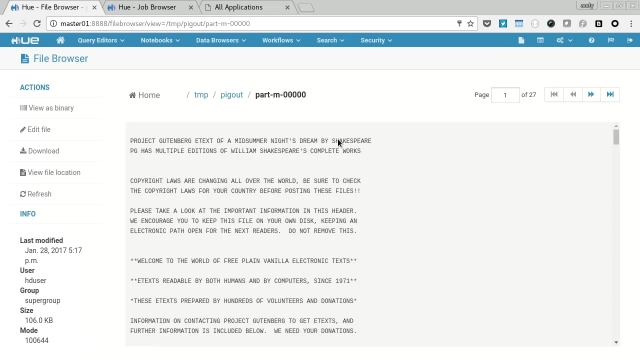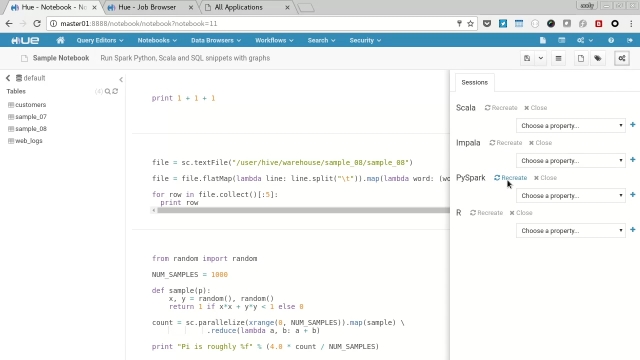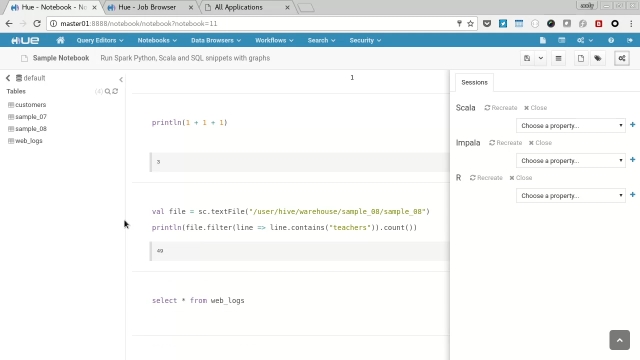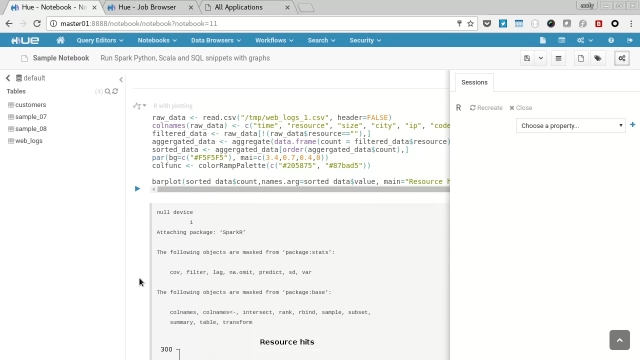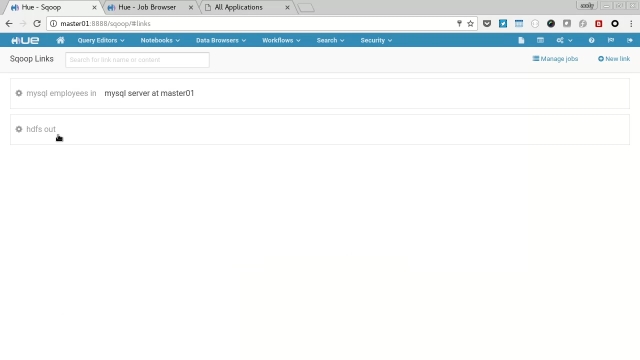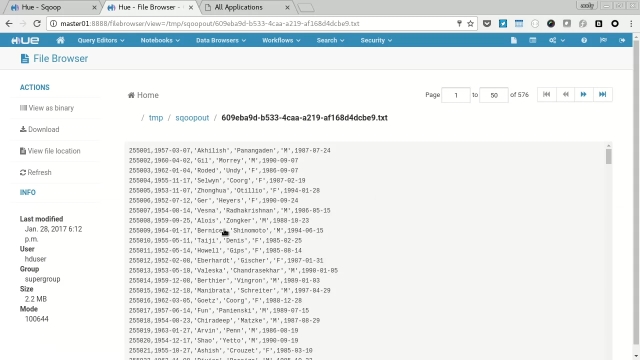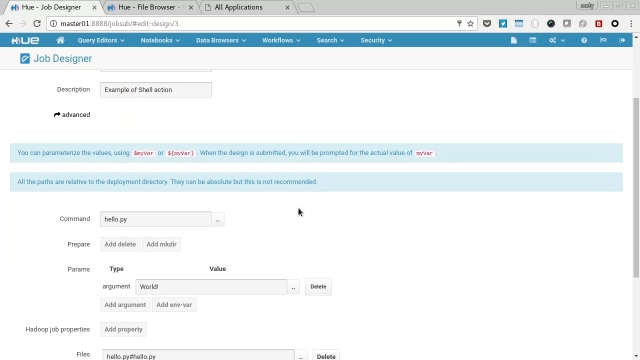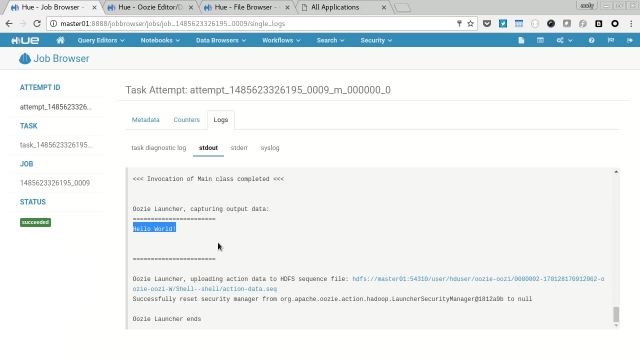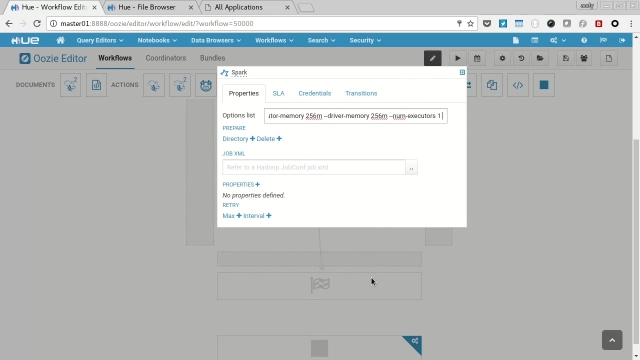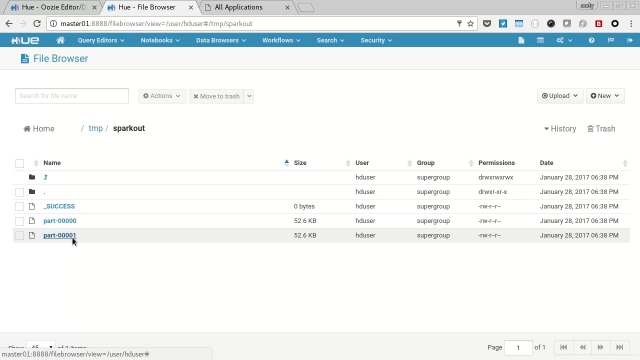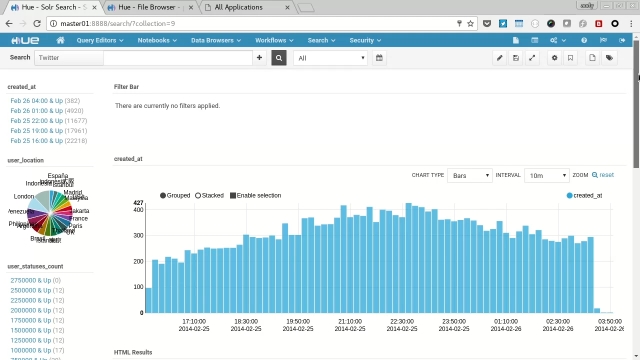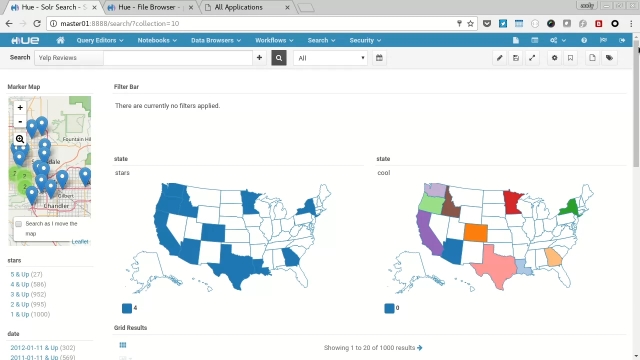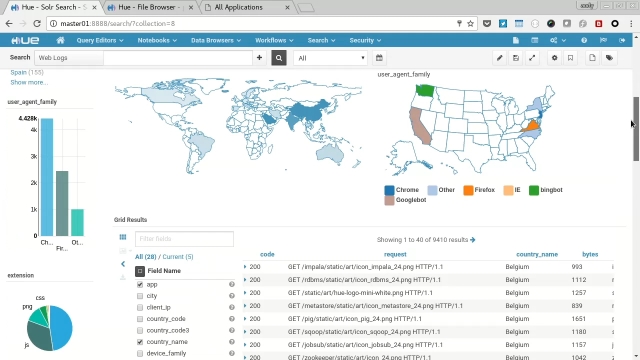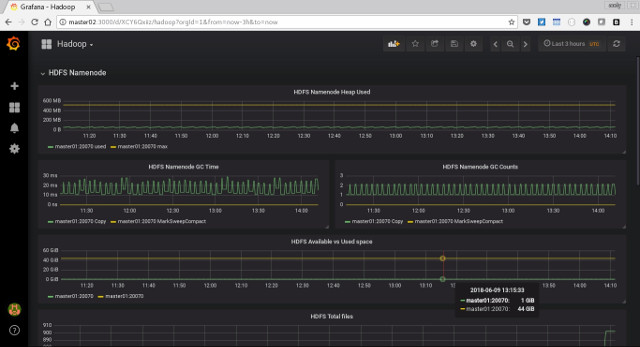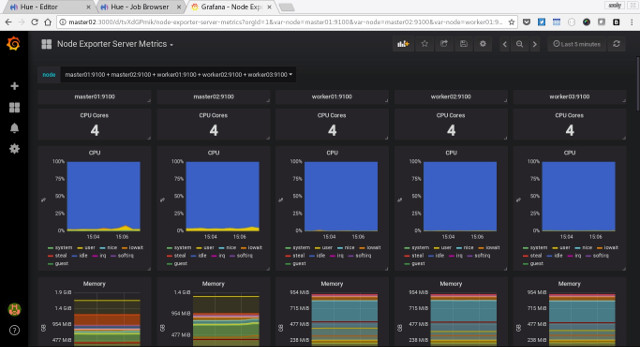This project contains the configuration files and chef code to configure a cluster of five Raspberry Pi 3s as a working Hadoop running Hue.
This video shows how to set up and configure the cluster using this code, however this is using the "1.0" tag which is configured to use wifi based networking.
This has now been changed and uses wired networking to add improvements for speed and reliability of network connectivity.
The versions of installed Hadoop components are:
- hadoop 2.6.4
- hue 3.11.0
- hbase 1.2.4
- pig 0.12.1
- hive 1.2.1
- spark 1.6.2
- livy 0.2.0
- oozie 4.3.0
- sqoop 1.99.4
- solr 4.10.4
- impala - not supported
Metrics collection and visualisation has been added with the addition of Prometheus and Grafana
Running Hadoop on Rasberry Pis is not a new idea, a lot of work has been done by individuals and I wanted to make sure their efforts were recognised. Their work has formed the basis of my attempts and inspired me to start the project.
- Jamie Whitehorn - https://www.youtube.com/watch?v=n6ONKshWSMg
- Jonas Widrikson - http://www.widriksson.com/raspberry-pi-2-hadoop-2-cluster/
- Carsten Mönning - https://blogs.sap.com/2015/04/25/a-hadoop-data-lab-project-on-raspberry-pi-part-14/
- Bram Vandewalle - http://www.becausewecangeek.com/building-a-raspberry-pi-hadoop-cluster-part-1/
- DQYDJ - https://dqydj.com/raspberry-pi-hadoop-cluster-apache-spark-yarn/
My day job uses the Cloudera distribution of Hadoop, which provides a great management interface, but that means I'm somewhat shielded from the inner workings of Hadoop configuration and tooling. I decided to put this distribution together to see if was feasible/practical to run Hadoop on a cluster of Raspberry Pis, but also to get more exposure to it's tooling and configuration. At the same time I wanted a feature rich and easy to use "suite" of tools so I based the project around Hue. I also wanted it to be easily recreateable so used Chef as a way to provision the nodes.
There are some caveates to bear in mind when using this tool.
- No Impala - IMHO I don't think the Pi has enough power whilst running other Hadoop components - happy to receive pull requests :-)
- No Sentry - access to the data on the cluster will be based around HDFS security.
- Not a production reference - it's a learning exercise, given the performance of the cluster you really wouldn't want to run anything "real" on there.
- Teeny amount of memory so only basic stuff - The 1GB of ram on the Pi is a real limitation, you're really only going to be able to one task at a time, so go easy on it.
- Its slowwwwwwwww - the combination of teeny amount of RAM and only 4 cores means this is not built for speed, be realistic with your expectations!
- Setup requires basic linux command line fu and understanding of network configuration - you are going to be compiling applications, running chef code and possibly doing a little fault finding, you'll need some moderate linux sysadmin skills for this.
- It's compiles and configures correctly as of NOW - there are loads of dependencies on 3rd party libraries and packages, both when compiling binaries or configuring the cluster, but things get move, deleted or just change, you'll need to be able to diagnose problems and change settings.
- Ask if you want help - github issues are ideal but please be clear in what attempts you have made to diagnose and fix.
To build the cluster you are going to need:
- 5 x Raspberry Pi 3s
- Nylon Spacers to stack the Pis
- Acrylic Raspberry Pi case for base and lid to keep the dust off
- Network switch, I use a USB powered 8 port Edimax ES-5800G
- Network cables
- Anker 60w 6 usb port hub
- 6 usb cables
- 5 x Samsung Evo+64GB micro sd cards
- Computer for administering via ssh, running a webserver and a web browser to access Hue
Just a quick note on the micro sd cards, perfromance of cards can vary wildly, I was recommended the Evo+ cards as their performance at reading and writing small files is very good, you can check the performance of yours using https://github.com/geerlingguy/raspberry-pi-dramble/blob/master/setup/benchmarks/microsd-benchmarks.sh
Although most of hadoop eco system is written in java and available in binary format, there are some components that need to be built for the target architecture for performance. As the Raspberry Pi is ARM based we simply can't take the precompiled binaries and run them, we're going to have to compile those. These are Hadoop (with the correct version of protobuf libraries that we will also need to build), Oozie and Hue.
Install the Rasbian Jessie Lite version dated 05/07/17 onto you sd card, the development of the project was based around this version.
http://downloads.raspberrypi.org/raspbian_lite/images/raspbian_lite-2017-07-05/
This version is the latest of the Jessie distribution, I have tried using stretch but hit several problems compiling binaries, so I'm sticking with this version of Jessie. When you write the image to your SD card remember to enable the ssh server by creating an empty file called "ssh" in the boot partition e.g.
sudo touch /path-to-where-your-sd-card-is-mounted/boot/ssh
replacing the path accordingly.
Boot the pi and locate you it's ip address via some form of network scan e.g.
nmap -sP 192.168.2.0/24 | grep rasp
and ssh to it as the pi user. then download and unpack the protobuf v2.5 source, tweak the build script so that it refers to the new location of the google test suite and build and install the libraries:
sudo -i
apt-get update
apt-get install dh-autoreconf
wget https://github.com/google/protobuf/archive/v2.5.0.zip
unzip v2.5.0.zip
cd protobuf-2.5.0
vi autogen.sh
Change the references to the google test suite:
# Check that gtest is present. Usually it is already there since the
# directory is set up as an SVN external.
if test ! -e gtest; then
echo "Google Test not present. Fetching gtest-1.5.0 from the web..."
wget https://github.com/google/googletest/archive/release-1.5.0.zip
unzip release-1.5.0.zip
mv googletest-release-1.5.0 gtest
fi
Then generate the build configuration files
./autogen.sh
./configure --prefix=/usr
Build and install protobuf
make
make check
make install
We now need to compile the Hadoop binaries, download and unpack the Hadoop 2.6.4 source, tweak pom.xml so it bypasses the documentation generation as this fails on the Pi, apply the HADOOP-9320 patch and build the binary.
cd
apt-get install oracle-java8-jdk
wget http://apache.mirror.anlx.net/hadoop/common/hadoop-2.6.4/hadoop-2.6.4-src.tar.gz
tar -zxvf hadoop-2.6.4-src.tar.gz
vi hadoop-2.6.4-src/pom.xml
Disable the problem step in by adding the following to <properties>...</properties>
<additionalparam>-Xdoclint:none</additionalparam>
Next apply the HADOOP-9320 patch
cd hadoop-2.6.4-src/hadoop-common-project/hadoop-common/src
wget https://issues.apache.org/jira/secure/attachment/12570212/HADOOP-9320.patch
patch < HADOOP-9320.patch
cd ~/hadoop-2.6.4-src/
Next install a whole bunch of build tools and libraries:
apt-get install maven build-essential autoconf automake libtool cmake zlib1g-dev pkg-config libssl-dev libfuse-dev libsnappy-dev libsnappy-java libbz2-dev
Then run the build using maven
sudo mvn package -Pdist,native -DskipTests -Dtar
Once build package the archive ready for deployment
cd hadoop-dist/target/
cp -R hadoop-2.6.4 /opt/hadoop-2.6.4
cd /opt
tar -zcvf /root/hadoop-2.6.4.armf.tar.gz hadoop-2.6.4
Download the Hue 3.11.0 source, unpack it, apply the necessary patches and tweak the spark_shell.py so it defaults to 256MB for spark driver and executor memory rather than 1GB.
Install the build dependencies:
apt-get install python-dev libsasl2-dev libxml2-dev libxslt-dev libkrb5-dev libffi-dev libldap2-dev libmysqlclient-dev libsqlite3-dev libgmp3-dev libssl-dev
Download and unpack the Hue source
cd /opt
wget https://dl.dropboxusercontent.com/u/730827/hue/releases/3.11.0/hue-3.11.0.tgz
tar -zxvf hue-3.11.0.tgz
cd hue-3.11.0
Download the patch to fix the example loading issues with 3.11.0, patch the desktop/core/src/desktop/api2.py and desktop/core/src/desktop/tests_doc2.py files:
wget https://github.com/cloudera/hue/commit/b059cec5c55737af3ceeb3a8cb2c0ce4e4d94b4d.patch
patch < b059cec5c55737af3ceeb3a8cb2c0ce4e4d94b4d.patch
Next using your favourite editor change the driverMemory and executorMemory defaults from 1GB to 256MB in desktop/libs/notebook/src/notebook/connectors/spark_shell.py
Then build the apps
make apps
Then package them up:
cd /opt
tar -zcvf /root/hue-3.11.0.armf.tar.gz hue-3.11.0
Finally we need to compile oozie. Download the oozie 4.3.10 source and unpack it, we need to change the target java version to 1.8 in the pom.xml file, then build the binaries, download the ext-2.2. library (to enable the oozie web interface) and copy to the applicable folder and package the files.
Download the files and unpack:
cd
apt-get install oracle-java8-jdk maven
wget http://archive.apache.org/dist/oozie/4.3.0/oozie-4.3.0.tar.gz
tar -zxvf oozie-4.3.0.tar.gz
cd oozie-4.3.0/
Change the target java version to 1.8 in pom.xml, then set a few environment variables to stop the build process running out of memory, and build the binary:
export MAVEN_OPTS='-Xmx512m -XX:MaxPermSize=128m'
bin/mkdistro.sh -DskipTests -Puber
Now download the ext-2.2 library and package the files:
cd /root/oozie-4.3.0/distro/target/oozie-4.3.0-distro/oozie-4.3.0
mkdir libext
cd libext
wget http://archive.cloudera.com/gplextras/misc/ext-2.2.zip
cd /root/oozie-4.3.0/distro/target/oozie-4.3.0-distro/
tar -zcvf /root/oozie-4.3.0.armf.tar.gz oozie-4.3.0
Transfer the compiled binary files to you computer and start the python webserver to make them available to the pis as you configure the cluster: python -m SimpleHTTPServer
The cluster will comprise of 5 Raspberry Pis, 3 of them will be configured as worker nodes (worker01, worker02 and worker03) and have the HDFS Datnode and Yarn Nodemanager Hadoop components installed. The remaining two Pis will be setup as master01 and master02.
The master nodes will have the the Hadoop components:
master01
- HDFS Namenode
- Yarn Resource Manager
- Hue
- Hive
- Pig
- Oozie
- Sqoop
master02
- Hbase
- Zookeeper
- Spark & Livy
- Solr
The cluster is setup to run on the 192.168.2.x network range:
- 192.168.2.21 - master01
- 192.168.2.22 - master02
- 192.168.2.31 - worker01
- 192.168.2.32 - worker02
- 192.168.2.33 - worker03
- 192.168.2.50 - administering computer running python webserver
You can modify the network configuration by modifying the chef attributes or refactoring the network recipe. You may also want to add the nodes to your administering computer /etc/hosts file.
Note: the 3.11 branch still contains the original configuration for wifi networking should you want to run your cluster over wifi.
Firstly write the Jessie Lite version dated 05/07/17 onto your sd cards, remember to enable the ssh server byc reating an empty file called "ssh" in the boot partition e.g.
sudo touch /path-to-where-your-sd-card-is-mounted/boot/ssh
replacing the path accordingly.
We will setup the Pis in turn, worker01-03 and then master02, for the final step when we setup master01 which will need all the Pi's powered on as it modifies files on the HDFS file system by starting the cluster.
Insert the first sd card into one of your Pis, connect the ethernet cable and power it up, wait a minute whilst the Pi boots and SSH into the pi, you can determine the ip address of your pi by either using a network scanner e.g.
nmap -sP 192.168.2.0/24 | grep rasp
alternatively you could connect the pi to the hdmi and keyboard and work directly on it.
Once we have ssh'ed into the Pi we need to update the system:
sudo -i
apt-get update
apt-get -y upgrade
Installed git and chef:
DEBIAN_FRONTEND=noninteractive apt-get -y install chef git
Clone the code from github to the Pi:
git clone https://github.com/andyburgin/hadoopi.git
cd hadoopi
Then run chef against the worker01.json file
chef-solo -c solo.rb -j worker01.json
Wait for it to finish and:
poweroff
You now need to repeat these steps using a fresh sd card for worker02, worker03 and master02.
For the setup of master01 place the final sd card in the pi with the ethernet connection, setup the remaining 4 pis with the previously configured sd cards and power up all of the pis. As before ssh into the Pi you are configuring, update the system, install git & chef, clone the code, set you network SSID & password, then run:
chef-solo -c solo.rb -j master01-presetup.json
then reboot the pi for new network setting to take effect
Next we need an extra chef run to install additional Hadoop components and configure files on the HDFS filesystem that runs across the cluster:
chef-solo -c solo.rb -j master01.json
Finally ssh into all of the nodes (via their 192.168.2.x ip addresses):
poweroff
As a one off exercise before we start the cluster lets install some test data into mysql for later testing with sqoop, we do this before we start the Hadoop services as this will require too many system resources to tun both. SSH to master01 where our mysql instance runs (this is required to hold Hue configuration data, but we can also use it to hold test data too) and run:
sudo -i
git clone https://github.com/datacharmer/test_db.git
cd test_db
mysql < employees.sql
mysql -u root -e "CREATE USER 'hduser'@'%' IDENTIFIED BY 'hduser';"
mysql -u root -e "GRANT ALL PRIVILEGES on employees.* to 'hduser'@'%' WITH GRANT OPTION;"
mysql -u root -e "FLUSH PRIVILEGES;"
On master01 and master02 you will find some scripts in the /root/hadoopi/scripts folder. After powering on the cluster start the the hadoop services on master01 by issuing:
sudo -i
cd ~/hadoopi/scripts
./master01-startup.sh
Then on master02 run:
sudo -i
cd ~/hadoopi/scripts
./master02-startup.sh
Once those scripts have sucessfully run you are now ready to configure Hue.
We access hue via a web browser, point your web browser at:
http://master01:8888/
The first time you hit the url you'll be asked to create a Hue administrator user, the cluster is configured to work with the "hduser" user, so make sure you use that with a password of your choice.
From the "Quick Start Wizard" select the "examples" tab and one by one install each of the examples (don't start them all at once). Frome the "Data Browser" menu take a look at the "Metastore Tables" to check Hive data is available and the "HBase" option to view the data there. Finally select one of the Dashboards under the "Search" menu to check the Solr indexes are available.
Powering down the cluster is as easy as starting it, on master01 run:
sudo -i
cd ~/hadoopi/scripts
./master01-stop.sh
Then on master02 run:
sudo -i
cd ~/hadoopi/scripts
./master02-stop.sh
Finally on each of the nodes run:
sudo poweroff
From now on you can simply power on the cluster and run the startup scripts on master01 and master02 as root. Once you have finished using the cluster shut it down by running the stop script on master01 and master02, then running the "poweroff" command on each of the 5 nodes as root.
I won't go through every example installed in hue, watching the video will convey far more, but I'll cover some of the key ones and allow you to explore. Please remember the Raspberry Pi has a teeny amount of memory and runs things very slowly, be patient and don't submit more than one job at once, doing so will more than likely cause your jobs to fail.
From the "Query Editor" menu select "Hive", in the resulting query window select one of the example scripts e.g. "Sample Salary Growth" and hit the "play" button to submit the query.
Choose the "Job Browser" icon and open in a new tab, watch the job transition from Accepted->Running->Succeeded.
Return to the original query tab and you'll see the results displayed in the browser.
From the "Query Editor" menu select "Pig", then select the "samples" tab and then the "Upper Text (example)", in the resulting query editor amend the 2nd line to:
upper_case = FOREACH data GENERATE UPPER(text);
Click the play button to submit the query, you'll be prompted to specify an output path, so choose "/tmp/pigout" and click "Yes".
Go to the job browser and wait for the two generated jobs to finish, then click the "HDFS Browser" icon and navigate to /tmp/pigout and view one of the "part-m-????" files to see the generated uppercase text.
Spark notebooks are one of the best features of Hue, allowing you to edit code directly in the browser and run it via spark on the cluster. We'll try out the three supported languages Python, Scala and R (we don't have Impala support).
Select "Notebooks" menu and open the "Sample Notebook", we'll need to start a session for each language (one at a time, not all at once), we'll try Python first so click the "context" icon to open the context menu and then choose "Recreate" next to the PySpark option, this creates a Spark job viewable via the job browser.
When the session is ready and the job is running, click the "play" icon next to each of the 4 examples and the cluster will calculate the result and display it in the browser, feel free to experiment with the results and edit the code.
When you have finished with the PySpark examples you need to kill the session/job, so on the context menu click "close" next to the PySpark menu.
To try the Scala examples click "Recreate" next to the Scala option on the context menu to create the session and associated job. When running you'll be able to edit Scala code in the browser and interact with the results.
After trying both examples kill the session/job by closing the session on the context menu.
Skip over the Impala examples as they aren't supported.
Start the R session by clicking "create" next to the option and when the job/session have started edit the path in the R sample to /tmp/web_logs_1.csv The R example doesn't used HDFS so you'll need to SSH onto each worker and run:
curl https://raw.githubusercontent.com/cloudera/hue/master/apps/beeswax/data/web_logs_1.csv -o /tmp/web_logs_1.csv
Back on the Notebook click the play icon next to the code and examine the output including plot.
Finally close the session on the context menu so the spark job ends.
We're going to use Sqoop to transfer the employee sample data we installed earlier into HDFS. To do this we'll need to configure two Sqoop links and a Sqoop Job.
Create the first link by selecting the "Data Browser" and then "Sqoop". Choose "Manage Links" then "Click here to add one"
- Name: mysql employees in
- Connector: generic-jdbc-connector
- JDBC Driver Class: com.mysql.jdbc.Driver
- JDBC Connection String: mysql://master01/employees
- Username: hduser
- Password: ******
Then click "Save", choose "Manage Links" again to add the second link. Click "New Link" and enter the follwoing values:
- Name: hdfs out
- Connector: hdfs-connector
- JDBC Driver Class:
- JDBC Connection String:
- Username: hduser
- Password: ******
We need to then edit that link to complete setting it up, click "Manage Links" the the "hdfs out" link to bring up the edit page. Make the follwoing settings:
- Name: hdfs out
- HDFS URI: hdfs://master01:54310/
Finally click Save.
Next we need to configure the job, select "Click here to add one" and fill out the following:
Step 1: Information
- Name: import employees from mysql to hdfs
- From Link: mysql employees in
- To Link: hdfs out
Step 2: From
- Schema name: employees
- Table name: employees
- Table SQL statement:
- Table column names:
- Partition column name:
- Null value allowed for the partition column:
- Boundary query:
Step 3: To
- Output format: TEXT_FILE
- Compression format: NONE
- Custom compression format:
- Output directory: /tmp/sqoopout
Start the job by clicking "Save and run", navigate to the job browser and wait for the job to be submitted and run sucessfully. Then Navigate to hdfs browser and check the data in "/tmp/sqoopout"
There are many Ozzie examples installed, so I'll only talk about a few of them here. Lets firstly run the Shell example. Select "Query Editors" from the menu and the "Job Designer", next click the "Shell" example, you'll be presented with the job editor. I for scroll down you'll see a parameter to the "hello.py" command is "World!".
Click the "Submit" button (then confirm) and you'll be presented with the workflow view of the job, wait for the job to run and and select the log icon next "hello.py". In the resulting log you'll see the phrase "Hello World!"
Next let's look at a more complicated workflow, from the menu select "Workflows" -> "Editors" -> "Workflows", on the resulting page select "Spark" and you'll be presented with the job configuration page, for the spark workflow to run we will need to configure the settings for spark, click the "pen" icon to edit the job, next click the "cogs" icon on the spark step to access the steps properties. In the "Options List" filed enter:
--conf spark.testing.reservedMemory="64000000" --conf spark.testing.memory="128000000" --executor-memory 256m --driver-memory 256m --num-executors 1
Cilck the "disk" icon to save the changs to the workflow and click the "play" icon to submit the job, enter "/tmp/sparkout" into the output field and hit "Submit". Again you'll be presented with the workflow view, wait for the job to finish and then use the hdfs browser to navigate to the "/tmp/sparkout" folder and view one of the data files to check the spark job copied the intended files.
Select "Search" from the menu and then each of the dashboards in turn (Twitter, Yelp Reviews and Web Logs).
You'll see each present a variety of charts, graphs, maps and text along with interactive filtering features to explore the data held in the solr search indexes.
Grafana can be accessed via http://master02:3000 (default login admin/admin) where the following dashboards can be viewed:
-
Hadoop - Adapted from Wikimedia Dashboard https://grafana.wikimedia.org/dashboard/db/analytics-hadoop?orgId=1
-
HBase - Adapted from Bas Harenslak post https://blog.godatadriven.com/hbase-prometheus-monitoring
-
JVM - Grafana Dashboard - https://grafana.com/dashboards/3066
-
MySQL - Adapted from Wikimedia dasjboard - https://grafana.wikimedia.org/dashboard/db/mysql?orgId=1
-
Named Processes - Grafana Dashboard - https://grafana.com/dashboards/249
-
Node Exporter Full - Grafana Dashboard - https://grafana.com/dashboards/1860
-
Node Exporter Server Metrics - Grafana Dashboard - https://grafana.com/dashboards/405
-
Zookeeper - Adapted from Wikimedia dashboard - https://grafana.wikimedia.org/dashboard/db/zookeeper-old-graphite?refresh=5m&orgId=1
Grafana Dashboards are built using prometheus metrics collected by a number of exporters:
Node exporter - provides metrics about the state of each node
MySQL exporter - provides metrics for the mysql server
JMX exporter - exposes selected jmx metrics defined in:
- prometheus_hbase_jmx_config.yaml
- prometheus_hdfs_datanode_jmx_exporter.yaml
- prometheus_hdfs_namenode_jmx_exporter.yaml
- prometheus_hdfs_secondarynamenode_jmx_exporter.yaml
- prometheus_mapreduce_history_jmx_exporter.yaml
- prometheus_yarn_nodemanager_jmx_exporter.yaml
- prometheus_yarn_resourcemanager_jmx_exporter.yaml
Working out what metrics raw jmx can expose is shown in this example:
- https://github.com/devopsjedi/hadoop-docker-jmx_exporter/blob/master/hadoop-env.sh You can then use visualvm to attach to the demon and decide which metrics you need to expose in your jmx exporter yaml config file.
For details on how the jmx exporter works with Hadoop see these examples from Wikimedia:
- Add jmx exporter to Wikimedia Hadoop (excluding Hive and Oozie) https://phabricator.wikimedia.org/T177458
- https://github.com/wikimedia/puppet/tree/production/modules/profile/files/hadoop
- https://gerrit.wikimedia.org/r/#/c/operations/puppet/+/403123/ Not forgetting the jmx exporter documentation https://github.com/prometheus/jmx_exporter
Process exporter - some components don't expose metrics via jmx so we need to use the process exporter to grab values from /proc
- livy
- solr
- huesupervisor
- hueserver
- sqoop
- oozie
- hiverserver2
There are a couple of documents that detail how to add additional metrics for spark which may be added at a future date
- http://rokroskar.github.io/monitoring-spark-on-hadoop-with-prometheus-and-grafana.html
- https://argus-sec.com/monitoring-spark-prometheus/
You can access the prometheus metrics by visiting http://master02:9091/graph and viweing which targets it collects from http://master02:9091/targets please review the docs at https://prometheus.io for more details about adding the collection of additional metrics or adding in alerting.
Once you have finished experimenting with the cluster please don't just turn off the power, you risk corrupting your data and possibly the sd card. So follow the procedure of running the shutdown scripts on master01 and master02, then running the poweroff command on each of the pis before turning the power off.
I hope you have fun setting up and playing with the code, I learned a tonne of stuff configuring it and I hope you do too. If you have any improvements then please send pull requests to github, any problems and I'll respond to issues on there too.

